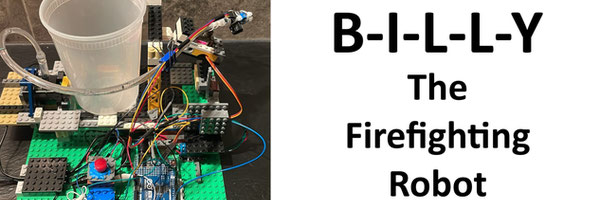BILLY - The Firefighting Robot
Grade 5
Presentation
Problem
Fire sprinklers aren't targeted; that could lead to fires not being extinguished and allow the fires to spread and cause big damage. Even if the fire is extinguished, putting it out might have resulted in using a lot of water because the sprinklers aren't targeted. Safety is also another problem once a human enters in close proximity of the fire where they become extremely vulnerable to their surroundings. This may result in death or injury through either toxic gases, severe burns or heat stroke.
Method
I built Billy with my father's guidance to test my hypothesis; Billy is a firefighting robot prototype. The hypothesis is that a more precise targeted system, can put out flames more effectively with minimal water usage. This would prevent the fire from spreading and causing unnecessary damage.
Materials Used
Billy was built using the materials in this list:
- a long tube
- water pump-12V
- servo motor
- Arduino UNO R4 Minima
- relay module
- On/Off button
- fire sensor
- valves
- wires
- alligator clips
- a spray nozzle
- blue tack
- Lego (main structure)
- electrical tape
The reason I used Lego as the main structure for Billy is because it was a creative way to express my love for Lego and a unique way to make the structure. It also came with its fair share of benefits such as certain parts being able to support multiple things at once or being sturdier in general.
When building Billy and testing him, I have encountered several problems. The table below is the summary of the issues and steps taken to resolve them.
| Problems Encountered During Prototyping | Steps Taken To Solve The Problem |
| Fire sensor sensibility being too high or too low | Troubleshooting and finding the right sensitivity, and wrapping tape around it to focus the sensing area |
| Code not functioning properly | Changing wire placement |
| The servo motor not rotating | Putting less load on the servo motor |
What I Learned
From this process of creating the Billy, I learned to:
- strip wires and twist the copper wire and secure it with electrical tape
- troubleshoot problems as I go along
- using a multi-meter to measure voltage
- how to upload codes to the Arduino board using the Arduino IDE program and various other tools.
- to conduct tests and demos
Analysis
This robot is very precise and could extinguish fires, making sure that none are left burning to ensure more safety. The robot is using the infrared principle to detect the fire which allows the robot to differentiate artificial fires from real ones. This prototype can also be functional indoors guarding highly flammable items and be able to extinguish them at a moment's notice. The main function of the robot is to extinguish fires before they can grow uncontrollably to a larger size and cause severe damage.
Conclusion
This robot has the potential to be used as an alternative to fire sprinklers because of the advantages it comes with. With future improvements to the robot, it could have a significant impact to preventing rapid spread of fires.
Benefits could include:
- Reduces risk for humans and property
- Can be an alternative to fire/safety sprinklers
- Since it is more precise it will lower water usage.
Future visions for BILLY could be:
- Potentially scaled bigger and be made mobile (on drones) to help with bush or forest fires that happen around Canada; to quickly detect, mobilize and put out fires while they are small.
Citations
References, concept and source code: https://www.youtube.com/watch?v=_XQu9LO1o2I
Acknowledgement
I would like to give special thanks to my father, Jonathan Chong, for devoting time and effort to guide me though this project. He never gave up on me and continuously encourage me to keep on going with this project at times where I felt a bit lost.
I am also grateful to Mr. Joshua B. Downey from Griffith Woods School for introducing me to the competition and guiding me through the whole project submission.
Thanks also go to CYSF for giving kids like me an opportunity to participate in this wonderful event like this.

